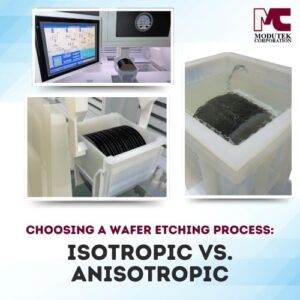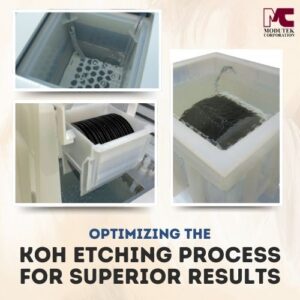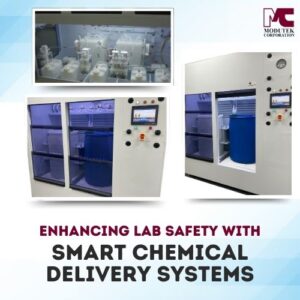![]() Editor’s Note: This article was originally published in September 2016 and has been updated with additional information and reposted in June 2023.
Editor’s Note: This article was originally published in September 2016 and has been updated with additional information and reposted in June 2023.
The production of semiconductor components relies on the etching of silicon wafers using various processes like KOH etching to create the necessary structures and connections. To meet etching requirements, Modutek offers cutting-edge wet bench technology and equipment suitable for many applications. Whether you are a manager overseeing semiconductor manufacturing facilities, a university researcher, or a process engineer within these organizations, Modutek’s equipment will fulfill your silicon wafer etching requirements.
KOH Etching:
KOH etching utilizes potassium hydroxide (KOH) to etch microscopic structures on silicon wafers. This process is highly dependent upon factors that include temperature of the etching bath, the concentration of KOH, and the crystalline structure and impurities within the silicon. KOH etching is known for being a cost-effective and repeatable technique and is well-known in the industry for its rapid etching capabilities.
Modutek provides PFA Teflon tanks from the TFa or TT series specifically tailored for KOH etching applications. These tanks offer excellent chemical resistance and ensure the safe and efficient implementation of this process. By using Modutek’s state-of-the-art wet bench technology and process components, semiconductor manufacturing facilities, research centers, and universities can rely on Modutek to meet their silicon wafer etching requirements.
Silicon Nitride Etch:
Silicon nitride is a commonly used masking material during the fabrication of integrated circuits. A thin silicon nitride film is applied on silicon wafers before being selectively etched away using hot phosphoric acid. The temperature bath is about 180 degrees Celsius, which is the boiling point of phosphoric acid.
Modutek provides Nb series silicon nitride etch baths that are part of a comprehensive suite of wet bench process components to achieve precise temperature control during silicon nitride etching processes. The silicon nitride etch bath achieves accurate process control and excellent repeatability by carefully controlling the ratio of deionized water to phosphoric acid. In addition, the high level of safety provided by Modutek’s equipment ensures a secure working environment.
Piranha Etch:
In semiconductor manufacturing, the Piranha Etch process is used for cleaning silicon wafers. The process consists of a mixture of sulfuric acid and hydrogen peroxide – typically in proportions of 3:1 for concentrated sulfuric acid to one part 30% hydrogen peroxide. This solution effectively removes organic compounds from wafer surfaces and oxidizes most metals.
Modutek focuses on understanding each customer’s specific silicon wafer cleaning requirements and offers tailored solutions from their extensive wet processing equipment selection. The in-house expertise Modutek provides heated quartz tanks to ensure that the Piranha etch process is carried out with precision and efficiency to ensure silicon wafers are clean and ready for additional processing.
Hydrofluoric Acid (HF) Clean:
Hydrofluoric Acid (HF) is used to specifically remove silicon dioxide (SiO2) layers from wafer surfaces. This is an essential process in semiconductor manufacturing applications, such as creating thin films and depositing new materials. Hydrofluoric Acid has high selectivity for SiO2, which makes it an effective choice for etching oxide layers.
Modutek provides specialized equipment to support the HF clean process. This includes wet benches and chemical delivery systems that offer precise control over HF solution, optimizing the etching process while maintaining a safe and controlled environment. By employing Modutek’s expertise and state-of-the-art equipment, semiconductor manufacturers can efficiently remove SiO2 layers to produce superior silicon wafers.
RCA (SC1&2) Clean:
The RCA Clean process consists of two sequential steps known as SC1 and SC2, and is an established method for eliminating organic and inorganic contaminants from silicon wafers. In the SC1 step, wafers are submerged in a solution consisting of deionized water, hydrogen peroxide (H2O2), and ammonium hydroxide (NH4OH). This solution effectively eliminates organic residues, particles, and metal ions from silicon wafers.
After the SC1 step, wafers undergo the SC2 step, which uses a solution of deionized water, hydrogen peroxide, and hydrochloric acid (HCl). SC2 removes metallic contaminants, native oxides, and any remaining impurities to achieve an ultra-clean surface.
Modutek offers advanced wet bench systems with precise chemical delivery and control systems to support the RCA (SC1&2) clean process. These systems ensure accurate mixing and consistent delivery of chemicals for reliable and consistent cleaning results.
In addition, Modutek’s wet bench technology also provides comprehensive rinsing capabilities for efficient removal of cleaning solutions that reduce contamination risks. Rinsing plays an integral part in eliminating residual cleaning solutions while mitigating the risk of contamination. By including advanced rinsing mechanisms, Modutek’s equipment ensures that wafers are thoroughly cleansed before moving on to further manufacturing steps.
Modutek’s Wet Bench and Process Component Solutions
As a premier provider of semiconductor manufacturing equipment for over 40 years, Modutek provides wet process equipment for a wide variety of semiconductor etching and cleaning applications. Modutek’s wet bench technology delivers reliable, repeatable results safely and accurately. In addition, Modutek helps customers find solutions that meet their semiconductor manufacturing requirements. Contact Modutek for a free consultation on selecting the right equipment to support your specific processing needs.




